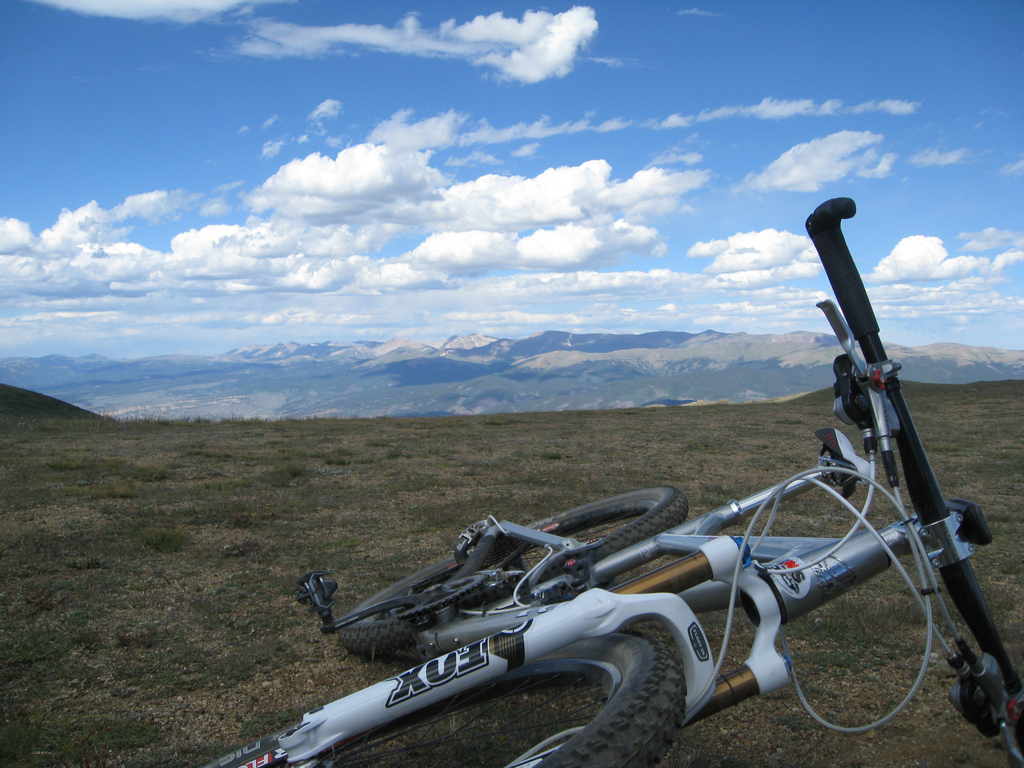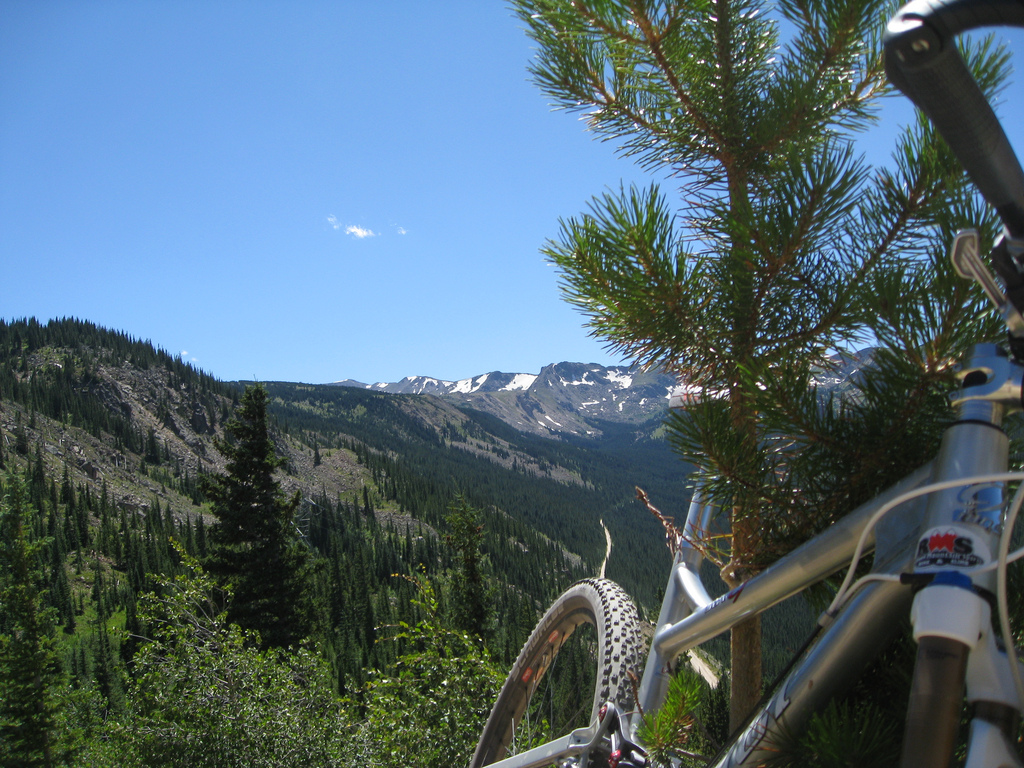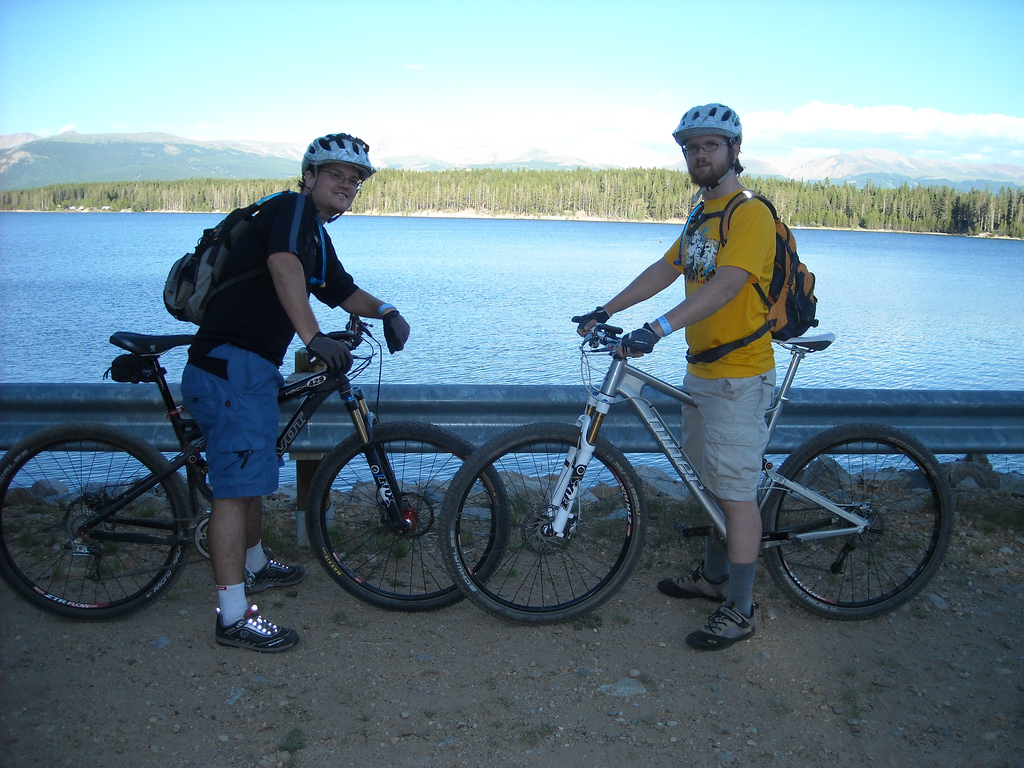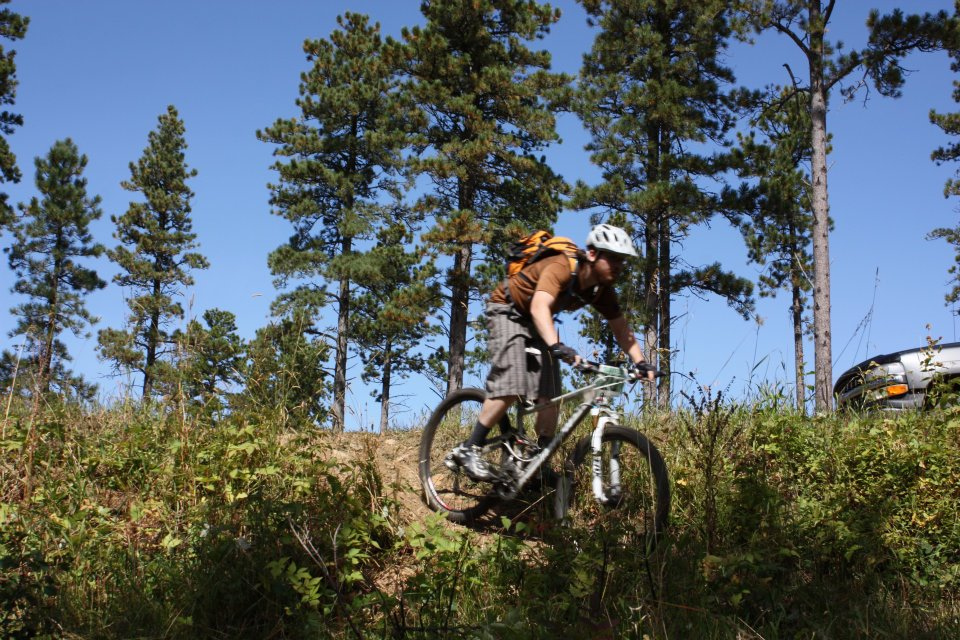I looked long and hard at full suspension 29’ers before pulling the trigger in June of 2011. The only full suspension I have ever owned was a 2002 Specialized Stumpjumper FSRxc and it ruined me on the entire category until I rode a Gary Fisher HiFi Pro 29’er in mid-2009. One ride on the HiFi and I knew a short travel 29″ bike was what I needed to be on.
Let me give a brief bit of perspective, I have spent a lot of time on hardtails and I generally prefer to be on one to this day, I also have a healthy appreciation for a full rigid — a lot of the time and for a lot of purposes you really just don’t need any form of active suspension. I find that a 29″ hardtail with a 2.1-2.25″ tire is usually plenty of bike for me on terrain where other riders absolutely insist on a 4″, 5″ or even 6″ travel bike. My rationale for stepping up to a short travel full suspension was that in the course of trying several out “just to see”, I found that they could be faster than a hardtail both climbing and descending on rough terrain. I also wanted a bike that I could do long, tough events on and still feel fresh enough to drive home afterwards.
I took my time evaluating the field of available short-travel 29″ bikes and rode several, including a newer HiFi, Specialized Epic 29 and Salsa Spearfish. All of these are great bikes, all with their own strengths and weaknesses. To be frank, one of them is probably more correct for a given rider based on their individual preferences than the other three, depending on the rider. One of the four is also definitely going to be more appropriate than the rest depending on the terrain it will be ridden on. While there are many, many different facets of these four bikes that I considered, including cost, full/partial cable housings, cable routing, suspension design, color availability, paint/coating type, available sizes/cockpit lengths, head angle, weight, chainstay length and wheelbase, etc. I eventually found that many of these points were moot as I narrowed these four bikes into three general categories based on their bottom bracket height. The height of the bottom bracket and subsequent pedal height dictates in large part how amenable the bike will be to a given type of terrain. At the end of my research into these bikes that I rode as well as numerous others I found myself first looking at the bottom bracket height to determine if it was within my preferred range and only then looking at all of my other requirements. The three basic classifications that I arrived at were a high bottom bracket, a good bike for extremely varied, rocky or steep terrain — “mountains”, the Niner has a high bottom bracket. An intermediate bottom bracket, middle of the road, generally fairly well suited to anything but most at-home in intermediate terrain, not climbing over rocks and downed trees or things of that nature. The HiFi and Epic have an intermediate bottom bracket height and either bike would work well in the Black Hills. The last category is, of course, bikes with a low bottom bracket. The argument in favor of a low bottom bracket seems to be increased stability, and while I disagree that this is necessarily the case, even giving the benefit of the doubt that it does lend stability I would still feel that other factors outweigh this, especially for the local Black Hills terrain. The Salsa Spearfish has a low bottom bracket and is what I have come to refer to as a “Flat Land” bike, a bike that is most appropriate well away from mountainous terrain in states such as Minnesota, where Salsa is headquartered. In rough terrain such as is often found in the Black Hills, a bike with a low bottom bracket means many more pedal strikes and more work clearing every obstacle. On the other hand, a bike with a high bottom bracket means you can just keep those cranks spinning and really rip over almost any terrain.
My purchase decision was subsequently narrowed to the Niner Jet9, but I could have ended up on a Trek HiFi or a Specialized Epic 29 and I think I would have been happy on either of those bikes. I will refrain from discussing all of the specific details that sealed up my personal decision, because anyone else in this position should form their own criteria and go out and ride all three of these bikes and maybe a few others before deciding which bike is best for them. In the event that you are considering a Jet9, the rest of this posting will be a review covering the approximately six months I have spent with my Jet9 that may help you to answer whether it is the right bike or not versus the other options available.
I probably would not have been comfortable purchasing the Niner without being able to demo both a medium and a large first. I am 5’11” and as such am in-between sizing, but I also have a bit of a unique fit in that I have a shorter than typical inseam and a longer torso. This means I generally prefer to “size up” when between sizes on bikes, but the Large Niner looks pretty big on paper and so I simply wasn’t sure. Fortunately I was able to ride both a medium and large during the Black Hills Fat Tire Festival. The medium definitely fit and I could have ridden it comfortably, but I did not like how far I was over the front-end of the bike and felt I could have used just a bit more wheelbase. The large, on the other hand, was on the verge of being too large as I felt I was having a hard time getting enough weight on the front tire in tight corners. The Niner guys were happy to help me dial in the fit until I was happy with it and after moving the saddle forward and significantly lowering the bar height the bike felt just like it should, very impressive. The first impression of the fit was not golden, but I gave it a chance and it really ended up surprising me in the end.
The Jet9 with a 100mm fork has really “neutral” manners. Most bikes in this class do now. I could spend a bunch of time talking about its handling but really it is not far from the middle of the road and if you can come to terms with any short travel 29er you can come to terms with this one just as easily. It does have shorter chainstays than most, which I consider to be a benefit. When you get down to how the Niner, the HiFi and the Epic are different, from a riders perspective, probably the biggest difference is in the distinctly different rear suspension designs. The HiFi seemed to start out fairly firm, not overly firm but “race-y” feeling firm, but once you start getting into the travel it opens up a bit and feels like a lot of travel over rough terrain. The Epic is probably the bike of choice for someone who wants one that feels like a hardtail. With the Brain setup to my preference it literally rode just like a hardtail over smoother terrain but then opened up and really took the edge off of the moderate to large sized bumps. If I were a more serious racer and my longest events were in the neighborhood of 50 miles, or I raced a lot of longer but smoother endurance races a carbon Epic would have been quite appealing. In terms of which of these two bikes rode more like the Jet9, it would be the Trek, but they are still distinctly different. The Jet9 is also a bit stiff in the early stroke, but doesn’t feel quite as race-inspired as the HiFi, the Niner CVA suspension seems to have a bit better small bump compliance without any sacrifice in efficiency. Similar to the Trek, the Jet9’s rear suspension seems to “open up” through the mid-stroke, but begins to ramp back up sooner as the amount of travel is less.
The Niner Jet9 with the SRAM x7 build kit from Niner is a good deal at about $2,800 right now. At the time it was priced at $3,100 which I thought a bit excessive, and I also had a 3×9 drive-train that I could use so I ordered just the frame. I was split between two colors, the Black Anodized and the Raw. The Raw isn’t actually “raw” as it is raw with a glossy clear coat over it. I wanted one of these two options because I thought the finish would be the most durable or at least show chips and scratches the least. In the end I went with the Raw for purely aesthetic reasons.
As is usually the case when piecing something together yourself, everything will be there except for that one part you need and this bike build failed to buck that trend. The headset did not arrive in time for my first out of state event of the season, the Laramie Enduro. The bike ended up being put together at the last minute using a different headset sourced from a local shop and was not ridden more than a few hundred yards before being loaded on top of the car to head to Laramie, WY. I was able to spend a bit of time the night before the race spinning around a parking lot dialing in the fit as best I could and setting shock pressures but at the start of the event the bike probably had a mile or so on it. You can read my review of the event here, it was a good time but definitely would have been a better time had I been able to dial in the bike a little better. Everything worked, though, zero mechanical issues and both shocks performed better than expected given the limited time I had to dial them in. The rear shock ended up being set up a bit soft, but the suspension is efficient enough that it was not an issue and having tried more things now I tend to keep it on the soft side. The fork was much too stiff as I was running about 10psi more than I now prefer, I did not use nearly all of the travel even though the course had rough sections but much of the course was gravel road so it did not prove to be much of an issue. This was my first time riding in that area, the race was advertised as largely single-track and the Jet9 was intended as sort of an “all mountain endurance bike” for me. I figured that a seventy mile event with lots of single-track would be perfect for this type of bike but really I was wrong. The Niner performed very well but it was just a little too much bike for my taste, if I do the Laramie Enduro again it will be on a hardtail.
The build:
- Large Niner Jet9 Frame, Raw
- Polished Chris King Tapered Headset
- Polished Chris King Stepped Bottom Bracket
- Polished Thomson Seatpost
- Polished Thomson Seat Collar
- Polished Thomson Stem
- Polished Chris King Top Cap and Spacers
- Fox 32 Float 29 100 FIT RLC Fork, Tapered, 15QR
- Black Chris King ISO Hubs, 15mm SD Front, 135×10 Rear
- Black Stans Flow Rims
- Black DT-Swiss Competition Spokes
- Black DT-Swiss Brass Spoke Nipples
- Schwalbe Racing Ralph 2.25″ SnakeSkin Rear Tire
- Schwalbe Nobby Nic 2.25″ SnakeSkin Front Tire
- White Fizik Gobi XM K:ium Saddle
- Ergon GX2 Grips
- Niner Carbon Handlebar
- Time ATAC XS Pedals
- King Stainless Bottle Cage
- SRAM x.9 Shifters
- Truvativ Stylo 3×9 Crankset
- SRAM PG980 Cassette
- SRAM x.9 Rear Derailleur
- Shimano XT M770 Front Derailleur
- Avid Juicy 7 Brakes, 185/160mm G3 Rotors
- Total Weight: 29lb 2oz
As can be seen from the build, for a short travel bike I am running a ton of wheel and tire. Here in the Black Hills, riding at Storm, the Victoria Lake loops, on the Centennial and many other places I really, really enjoy this setup. For a rough and challenging 35 mile race like the Sturgis B.A.M. Knifeblade I think it is setup perfectly. For longer events or a bit smoother trails or rides/races that work in a lot of gravel road the wheels and tires can be a bit much, however. For their size the tires roll remarkably well, even on pavement, and I will absolutely keep this tire and wheel setup on the bike for most outings. For competition use the wheel and tire collectively are a bit too much, though and in the future I will have a lighter wheelset with a more competition-oriented tire for the 10-20% of my riding that demands it.
The feeling that I had too much bike and definitely too much wheel and tire on that bike persisted when I attempted the Leadville MTB 100 in August. I did not finish the event, but the blame for that does not belong to the bike, although I did have some minor issues during this race. At the start of Leadville the Jet9 only had 250 miles or so on it, but the 3×9 drivetrain had probably close to 2000. It was getting to be about time to think about replacing the small and middle chainrings, but they were not what I would consider to be bad yet. The course features a lot of gravel road and a lot of high-speed sections, so there was plenty of opportunity for riders in front of me to kick up dust and after collecting it for about 45 miles without lube my drivetrain began to chain-suck. If you are unfamiliar with this phenomenon it occurs when the front chainring does not release the chain, for which there are numerous reasons, but when this happens the chain gets pulled up with the ring until it interferes with the drive-side chainstay or chainstay yoke. On many bikes this is simply an annoyance that will chip your finish up a bit. On the Jet9 it is a far more serious issue, because of the lack of clearance between the drive-side chainstay yoke and the chainrings, “chain suck” will turn into “chain stuck” as the chain gets wedged between the yoke and one of the larger chainrings. If you are quick you can un-stick the chain with a quick back-pedal, but otherwise it will sieze the pedals and require you to dismount and forcibly pry the chain loose. This is not a huge problem, nor is it a problem specific to the Jet9, but it is a problem that requires you to be more particular about drivetrain setup and maintenance than you might have to be on other bikes.
While I may have had “too much bike” for Laramie and Leadville, apart from setup issues they were very comfortable events, Leadville especially. I easily overtook 100+ riders on the outbound Powerline descent, which may not have been as easy on a hardtail or with less wheel and tire. When I pulled out of the race after 60 miles, because I didn’t think I could sustain the pace necessary to finish under 12 hours, I still felt very good. A bit sore in a couple of places, but that many hours in the saddle will do that no matter what, but generally I felt quite good and not at all “beat up” like I may have felt on a faster/racier bike.
It was not until after Leadville that I noticed two places that were being damaged due to chain slap that were not the chain-stay, which was wrapped. The chain could bounce up and hit the lower few inches of the drive-side seat-stay as well. Also, more problematic, the chain was bouncing up and hitting the chainstay yolk, just forward of the wrapped chainstay. This is really an issue because there is not any good way to wrap this yolk to protect it from damage. It probably would not affect the function or safety of the bike to let the chain chew up this part of the yolk, but it would certainly cause an eventual aesthetic issue, especially on a painted frame. I have taken to wrapping 5-6 zip ties around the yolk. This has two benefits, it not only protects the yolk from chain slap, it also helps to prevent the chain from becoming trapped under light chain-suck. While not something that would keep me from buying the bike, this is definitely a design flaw that Niner should address through a redesign or by providing some sort of molded guard for the region. Trek and Specialized are better in this area.
In September I completely the annual ritual, the Dakota Five-0 and the bike was superb. My best time to date, under 6 hours and I felt great at the finish line. Again, for a lot of this race the wheel and tire combo may have been a bit too much, especially noticeable on the climbs. On the other hand, it payed huge dividends on Dakota Ridge and the return trip down Tinton Trail. I feel pretty confident in saying now that a bike built to these spec’s would make a great one bike quiver for someone who lives in the Black Hills or somewhere with terrain like ours. It is definitely better suited to riding in the Spearfish region than the Salsa that took its name from there.
I have a few other minor quibbles with this bike, things that have cropped up and are worth noting:
Probably due to the tire size, the rear wheel can be difficult to remove and reinstall. It seems to be easiest if the rear derailleur is shifted into the third or fourth from the smallest cog prior.
I have run the bike with a regular quick release in the rear, King Fun Bolts and also with a DT RWS quick release (not the thru-bolt version). If I were building this bike again today I would either get a 10mm through-axle rear hub and run the DT RWS thru-bolt setup, or a standard rear hub and run the DT RWS quick release. Currently I run the latter and while the shoulder of the dropout forging can provide a bit of finger interference when tightening or loosening, it generally works fantastically with this frame. The King Fun Bolts were nearly impossible to tighten in a fashion that resulted in a straight rear wheel.
The chainstays are a nice S-bend piece of alloy and stay nicely tucked out of your way. The seat stays on the other hand are box tubing and I initially would catch my heels on them from time to time. Similarly, I would initially sometimes rub a calf on the rearward link of the upper pivot. This did not seem to be an issue any longer after the first 20-30 hours on the bike.
After six months I am still finding the Jet9 to be as capable and versatile as I hoped it would be when making the purchase. For the majority of my riding in the Black Hills I have literally zero complaints, it is the best compromise of go-fast/ride-everything/have-fun that I can imagine. Sure, sometimes I would prefer a hardtail, especially for events. Rarely I also find myself thinking I could do with just a bit more travel, but neither a hardtail or a longer travel bike would be as fast or as fun on the majority of the local terrain. There are a few small issues, but none so large as to make me wish I would have gone for the Trek or Specialized instead. This Jet9 may find itself joined by a hardtail Niner in the future.




If you are interested in getting on a Jet9, or any Niner, Jesse or Joe at Rushmore Mountain Sports would thoroughly enjoy getting you on one. They also carry Trek if a HiFi (now Superfly) or Rumblefish is more your cup-o-tea.